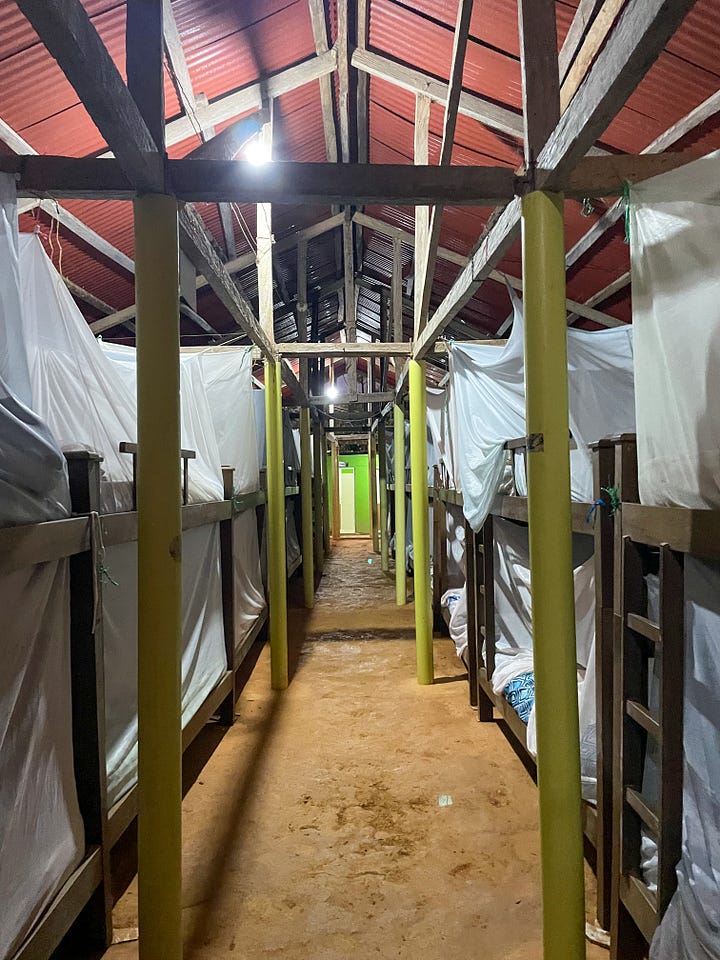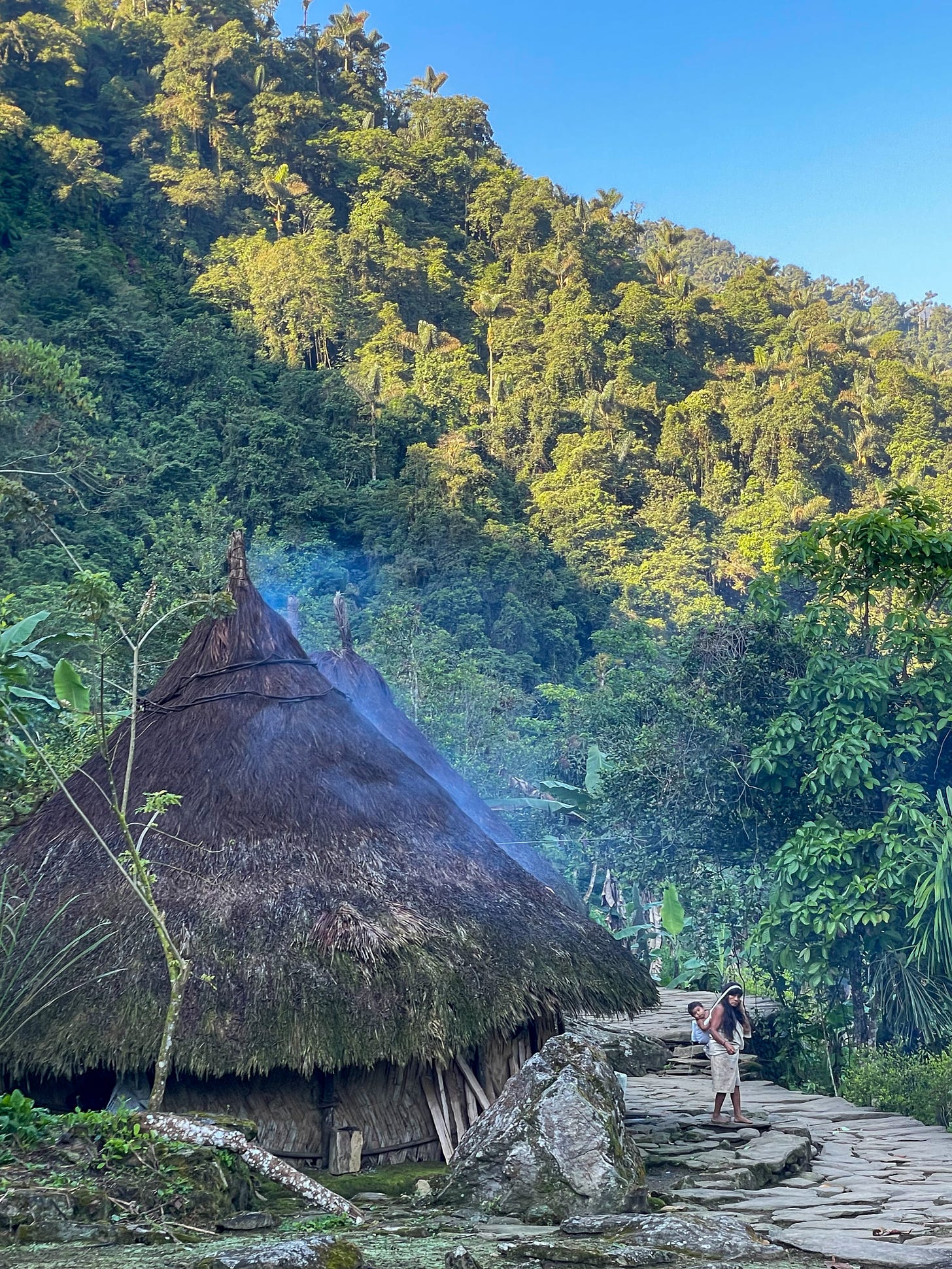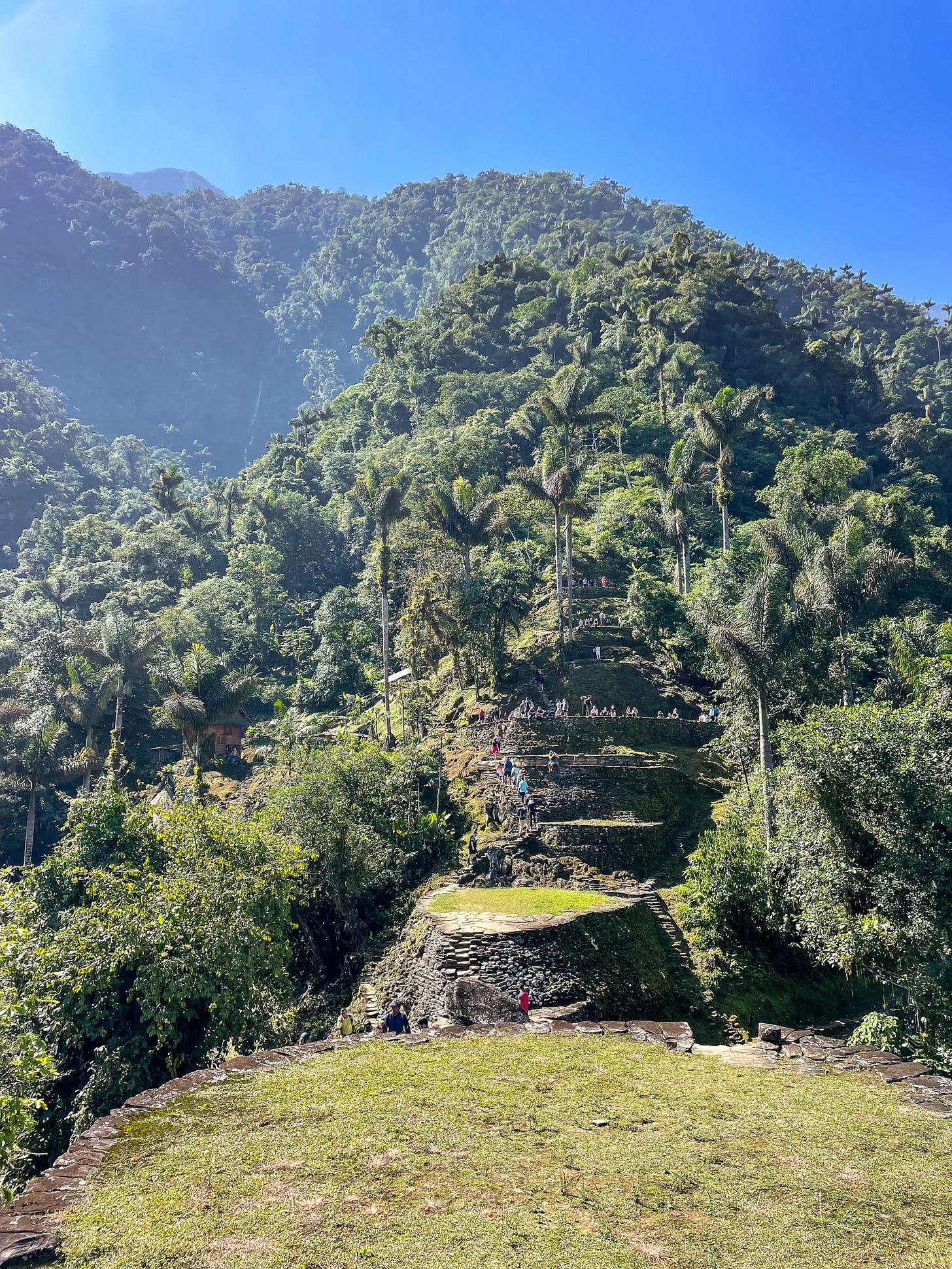The dark history of the Sierra Nevada, from conquerors to drug lords
Journal Entry #12: February 27th 2023, Medellin Colombia
Hola and welcome to Where on Planet Earth! In case you got here by accident and are not yet a subscriber, sign up below! For more visuals on our travels follow us on IG @whereonplanetearth
A few days ago we got back from la Ciudad Perdida, a multi day hiking route in the Sierra Nevada of the Colombian Caribbean, the world's highest coastal mountain range. We hiked up and down lush mountains and through indigenous communities for four days to get to Teyuna, an abandoned city built by the Tayronas indigenous group in 700 AD, 650 years before Machu Picchu. It’s a stunning hike in a deeply significant mountain rage. We learned a lot about the area, its harsh history with drugs, and the indigenous groups living there today.
The city was built by the Tayronas, who at one point numbered in the 500,000. When the Spanish arrived, lured by gold, they brought their diseases and their violence. This killed 98% of the Tayrona population. Nowadays, there are four different communities living in the Sierra Nevada, all descendants of the Tayrona, with a population of around 50,000: Kogui, Wiwa, Arhuaco, and Kankuamo. Two of those groups, the Kogui and the Wiwa, inhabit part of the hiking route to the Lost City, so you trek through their territory and some of their villages.
The “Lost City” - which was actually called Teyuna - was never truly lost, at least not to the indigenous communities of the area. They always knew it existed, but the city had a bad rep for a long time. Teyuna used to be were spiritual leaders lived and where special ceremonies and reunions happened. It’s thought to be the largest city of the Tayronas, with a capacity of 2,000 to 8,000 people. When the indigenous communities all around the mountain rage started to fall ill from foreign diseases, they went to Teyuna and their spiritual leaders to ask for a cure. Many died there and had to be buried in the city. So many of them that the city became a big cemetery and the communities started to believe they were being punished for giving away their gold, which represented their God the sun, called Saranqua. Because of this, the city was abandoned in 1650 and not resettled again until much later. In 1984, the Mamo, who is the main spiritual leader of the Koguis, decided to move there and today all the community leaders meet there every September, when the city is closed to tourism.
The city was “discovered” by outsiders in 1974, specifically by guaqueros or looters. The indigenous communities burry their dead under their houses with all their possessions, so the guaqueros knew exactly were to find the gold. The city was looted and destroyed almost entirely; they took everything they found, all the treasures now lost to the rest of the world. Eventually, they started getting into conflicts between them and some guaqueros were killed. This is what led to the government learning the place existed in 1975, appropriating the site, and eventually restoring it - ironically with the help of the guaqueros who were the only ones who knew how the city looked before the looting.
The history of the Sierra Nevada mountains is as interesting as the history of Teyuna. Starting in the 1950s the area has had three main cycles: marihuana, cocaine, and tourism. In the 1950s, dozens of Colombians from other parts of the country came to settle in the area, fleeing violence in other areas. In the Sierra they found fertile lands that seemingly did not belong to anyone, and whoever arrived settled in the paradise where bananas, avocados, and coffee grew, and also: marihuana.
Weed helped campesinos earn what they needed to survive and feed their families. The marihuana business brought lots of money to the area, so much so that the leaf became the local currency. This was the gateway to the farming of coca leaves, and behind the bonanza came the guerrillas followed by paramilitary groups. It was extremely violent for many decades, inconceivable to visit for both local and international tourism, and even those that lived there - such as our tour guide - told us they couldn’t leave the Sierra without permission. “They could kill you… they didn’t know what you were going to go do in Barranquilla or wherever”, our guide told us, “no one wants to go back to that. That is why, if we know of any family planting coca leaves we go have a chat with them, tell them this is not what we want”.
The conflict left more than 200,000 displaced, and thousands of others were kidnapped, disappeared, or killed. Eventually, in 2003 the Colombian government signed a peace deal with the paramilitary groups they helped to create, and almost 40,000 paramilitaries gave back their weapons. However, this did not mean the end of the conflict, at least not everywhere in the mountain rage. On the other side of the Sierra, where no tourists are hiking to Ciudad Perdida, or watching the sunset in Minca, or lounging on a beach in Tayrona National Park, there are still cocaine labs running full steam. After all, at least 70% of cocaine worldwide still comes from Colombia. Not all from the Sierra, but some of it still is.
Behind the peace that tourists perceive, there is surveillance by militiamen and millions of pesos that are extorted from tourist businesses and authorities. We find the situation quite similar to Mexico, and in many ways the similarities permeate the culture; narcotraffic unites the two countries in more ways than you would think.


In 2022 thousands of tourists visited the Lost City, and many more went to the surrounding area of Tayrona, Minca, Palomino, etc. As a tourist in these areas it’s easy to think there is no conflict, it’s easy to be marvel at how peaceful everything is after years and years of terrible war. And it’s undeniable that the country as a whole is leaps and bounds from where it used. I mean, we are in Medellin, what used to be the capital of the drug war; walking its art-filled Comuna 13 and chilling at hipster cafes.
But, in the end, nothing is really that simple.
Out of the four indigenous groups the Kogui are the ones that have preserved their characteristics the most and have had the least contact with people outside their group. They are also the largest of the four communities in the area. Here are some of the things we learned about their way of life:
In Colombia coca leaves are only officially allowed to be grown by indigenous communities because of their ceremonial purpose. Only the women in those communities are allowed to harvest it. The coca leaves are then roasted with a hot stone that is put into a bag along with the leaves and moved around. These are then chewed only by men.
The men receive a poporo when they come of age. The poporo is a small hollow gourd that is filled with lime, a type of powder produced by burning seashells with bamboo, boiling them in water, and then crushing them. They consider the poporo like their passport and carry it with them everywhere they go. As they chew coca leaves they extract a bit of lime from the gourd with a stick, which they then put in their mouth to combine with the coca. The alkalis from the seashells activate the coca leaves which provides a mild cocaine effect. Afterwards they also rub the mixture of saliva and lime over the gourd with the stick to form a hardened layer. They explain this as being meditative and stimulating, and a way to write their thoughts. The size of this layer on the gourd depends on the maturity and age of the Kogui man.
Natural fibers are made from the leaf of the agave by the man removing the outer skin of the leaf. Women then dye the fibers different colors with natural materials like leaves and tree bark, and then are the ones in charge of weaving the traditional bags that both men and women use. It can take 50 leaves and from 8 days to one month to make a medium size bag.
They worship the Sun and Mother Earth, and the two snowy peaks of the Sierra Nevada are considered the center of the world. This duality is their base for lots of other parts of their culture.
Men and women have very specific roles in the society. Women are believed to be more connected to Mother Earth and walk barefoot everywhere to always be in touch with the earth and get energy from it
Their homes are circular, symbolizing the womb and the sun. The roofs are made of palm wood and the walls are made of mud and wood. The houses have two peaks symbolizing the peaks in the Sierra Nevada.
Men and women live in separate houses right next to each other. Girls live with their mothers until they are married, and boys only up to a certain age and then move with their fathers. Women are married very young, and might have 8 to 10 children.
A burning fire is always in the middle of a women’s house because they are always at home cooking, and they also sleep around the fire to repel mosquitos. Because of this the age expectancy for women is very low at around 50 years old, in contrast to men which is around 80. Men also use fire but mostly just at nights, and during the day they are out of the house in the fields
The main difference between the four indigenous communities of the area is their language, which is so different they can’t understand each other without a translator. But there are also other things like the fact that the Wiwa wear hats and the Kougi don’t except for the Mamo (the spiritual leader)
Hope you found this info interesting! See you next week, with more on Medellin.















